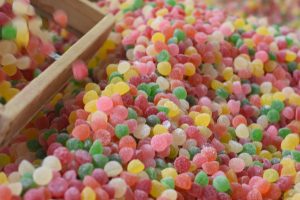
Life isn’t always sweet for the candy and confectionary industry. The industry works with many materials that are prone to bridging, ratholing, and material blocks. Without a good flow aid, production can stall and end up in a big, sticky mess. We will review the top challenges for material handling in the candy industry.
Most common challenges in material handling
Candy and confectionary can use many different materials, ranging from powders to oily or moist solids, small particles to large pieces of nuts, or brittle.
These materials have unique characteristics that can affect material flow and production.
- Free flowing and non-free flowing powders. While some flow freely from the force of gravity, others have more cohesive properties and are prone to packing during storage, and bridging and ratholing during production.
- Moist, oily, or sticky liquids and solids. These include raw materials like honey and end-products like caramel. Some materials have a tendency to cake and smear on vessel walls; others can crystallize or thicken under certain plant conditions, further inhibiting material flow.
- Blends and mixes. These can have ingredients that are different sizes, shapes, and densities. Aside from sticking to the sides of the vessel, the mix can segregate and compromise batch uniformity.
- Hygroscopic materials. These have a tendency to attract and retain moisture, which leads to clumping and caking during storage and mixing.
- Corrosive materials. The food industry uses concentrated acids, chlorides, and chemicals like sodium bisulfite and sodium sulfite. Aside from this, the food industry uses hot steam and chemical solutions to clean vessels and meet sanitation standards. This highly caustic environment means that the vessels—and any attached material flow aids—have to be made of materials that resist corrosion.
- Abrasive materials. Grains and hard crystals like polyols can wear down vessel walls.
- Perishable materials. Almost all materials used in making confectionaries are easily spoiled and contaminated and need both careful handling and first-in/first-out material flow.
Best flow aid for the candy industry
AirSweep is the best flow aid for tough materials. The powerful air pulses can handle cohesive powders and even moist, oily, and sticky mixes. It is used by food manufacturers around the world, many of whom switched to AirSweep because it performed better than vibrators, fluidizers, and other flow aids.
R. M. Palmer, a candy manufacturer in Pennsylvania, produces specialty holiday confections for US and international distribution. It uses a fine cocoa powder with 12% oil content, which caused bridging and ratholing in the hoppers and required manual cleaning every three to four days.
After installing AirSweep, the plant went from downtime every 3 or 4 days to “no breakdowns, replacements, or any problems whatsoever.” They were even able to add two production shifts per month, increasing productivity and profit margins so much that they were able to recover the cost of the system in just two months.
“AirSweep works,” he said. “It has a stronger air pulse than the bin aerators or fluidizers we previously installed. The air moves the powder down in a very large column so powder doesn’t stick to the walls.”
5 benefits of AirSweep for the candy industry
AirSweep’s unique construction also makes it ideal for the unique conditions of the candy and confectionary industry.
- Guaranteed on-demand, first-in / first-out flow prevents material stagnation and spoilage
- USDA-accepted design meets the strictest standards for sanitary equipment
- Air-tight nozzle snaps shut after each pulse, preventing fine powders and dust from entering the system
- Durable finish resists abrasion and corrosion and can be safely cleaned with chemical agents
- Fast and easy assembly allows the unit to be removed for cleaning without any special tools
Get a customized proposal for your process
AirSweep is used in thousands of plants around the world and has solved many challenges in material handling that other flow aids could not. Contact us to find out how you can improve your material flow.





Comments are closed